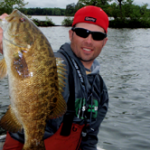A beneficial wind and its corresponding warming water temperatures drive feeding patterns in early spring and wake smallmouths up from their dormant winter state. Anglers who fail to understand wind patterns, and lack a sense of spring smallmouth lake locations, learn to embrace the skunk. Meanwhile those who follow the wind and have learned to use it to their advantage will experience the hot early season bite.
Lake Profile
Size: 400 acres
Lake Type: Mesotrophic
Maximum Depth: 35 feet
Avg. Depth Fished: 5 to 15 feet
Water Clarity: Moderately Clear
Primary Fishery: Musky, Walleye, Smallmouth Bass
Areas of Focus: Sun-exposed sand bars, rock bars, rock shoals, main lake points
Time of Day: 12 to 4 pm
Lure Used: Dynamic Lures JSpec (Holo Gold)

In early season, usually as early as mid-May, once water temperatures crest above 45 degrees, my best and most productive smallmouth bites of the year take place on lakes with rapidly warming shallow waters. On my inland lakes of Wisconsin, these early season bodies of water range anywhere from 100 to 500 acres in size – and definitely warm earlier than many of the larger lakes I fish most frequently. Following ice-out, most bass anglers will miss out on a short window of opportunity for better-than-average smallmouth fishing.
When smallmouths leave their wintering holes and begin staging for the spawn, it’s best to be at the edges of rocky shoals and spawning flats waiting for them to arrive. When and where they will show up in the most heavily concentrated wolf packs is determined by wind and the warm undercurrents it creates, and the angle and placement of the sunlight above.
In this video, the Dynamic Lures J-Spec proves its versatility as an extreme action suspending jerkbait. Professionally designed with an action and feel that has been tested extensively, its unique size and shape produce an erratic action that triggers aggressive bites.
With great suspending action the J-Spec is a great choice to use when targeting smallmouth bass in the shallows, and casting for walleyes. The J Spec suspending jerkbait rivals the best suspending hard baits on the market today. My favorites are Ghost Fish, Holo Gold, and Chartreuse Shad. The aggressiveness of each jerk and the length of the pause between them varies largely by water temperature and by the stage of any weather front pushing through. Cool water temperatures and post-frontal conditions call for a very slow approach while actively feeding smallmouths and warm water situations demand aggressive techniques.

Suspending jerkbaits catch early spring smallmouths better than most other baits I throw. Part of it is through technique while most of it is due to their capability to freeze in space and hover in the faces of fish.
I typically work the J Spec on 7 foot medium heavy action spinning rods and reels with 8 lb monofilament with sharp tugs. The rod and reel combination of choice on this particular early May outing was a 7 ft medium heavy Quantum Tour Edition rod with Quantum Catalyst 30PTi spinning reel with 8 lb. Cortland Endurance high-visibility orange monofilament.
When smallmouths rise up from their wintering holes is determined by water temperature, which is heavily influenced by sunlight and wind direction. It’s like clockwork, basically. When the water temperature hits a certain number, fish will rise from these habitats, and follow a trail of underwater structure to the shallows they will be using for feeding and spawning.
Early season smallmouths tend to move onto their shoals and spawning flats in pods and sometimes in heavy concentrations. Fan cast these areas in order to locate them. The key to catching early season smallmouth bass like this is to have a sun and wind-based strategy. It’s always tempting to cover as many spots as possible to maximize productivity but in early spring it’s unnecessary. Most early season trophy smallmouth will be scored from specific spots on ice-free lake where the water is warmest.













